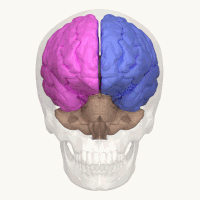
Photo from wikipedia
There is growing interest concerning the ways in which the human body, both one's own and that of others, is represented in the developing human brain. In two experiments with… Click to show full abstract
There is growing interest concerning the ways in which the human body, both one's own and that of others, is represented in the developing human brain. In two experiments with 7-month-old infants, we employed advances in infant magnetoencephalography (MEG) brain imaging to address novel questions concerning body representations in early development. Experiment 1 evaluated the spatiotemporal organization of infants' brain responses to being touched. A punctate touch to infants' hands and feet produced significant activation in the hand and foot areas of contralateral primary somatosensory cortex as well as in other parietal and frontal areas. Experiment 2 explored infant brain responses to visually perceiving another person's hand or foot being touched. Results showed significant activation in early visual regions and also in regions thought to be involved in multisensory body and self-other processing. Furthermore, observed touch of the hand and foot activated the infant's own primary somatosensory cortex, although less consistently than felt touch. These findings shed light on aspects of early social cognition, including action imitation, which may build, at least in part, on infant neural representations that map equivalences between the bodies of self and other.
Journal Title: Developmental science
Year Published: 2018
Link to full text (if available)
Share on Social Media: Sign Up to like & get
recommendations!